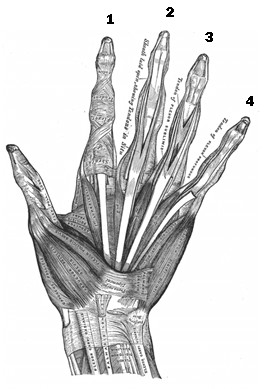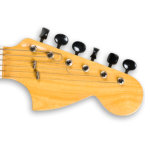For many guitarists, the little finger can be the source of grief.
Why is this?
 First of all, the pinky finger has some mechanical and muscular disadvantages when compared to other fingers. This usually means that the pinky gets neglected.
First of all, the pinky finger has some mechanical and muscular disadvantages when compared to other fingers. This usually means that the pinky gets neglected.
Think about how much you use your pinky in your day-to-day activities. Early 17th century anatomists even named the little finger “auricularis” (ear finger) implying its best use was for ear wax removal.
Unless you do lots of typing, your pinky tends to get very little specialized use, and as you no doubt know, typing and playing the guitar are two very different things! To overcome the inherent mechanical and muscular disadvantages, certain things need to be done…
Do You Make This Mistake When You Learn a New Song?
When starting to learn a new guitar song, one of the first things you need to do is determine the best fingerings for the riffs, guitar solos, and any new chords you may encounter.
Most guitarists go with what “feels” the easiest. Unfortunately, this usually means neglecting, or completely ignoring the pinky.
The correct fingerings may feel tricky at first, but with a bit of practice, they will become second nature and most importantly, allow for proper all around technique development.
The Major Limiting Factor for Most Guitarists
Most guitar player’s development is limited by the fingerings they use. When the wrong fingerings are used, it becomes extremely difficult to advance on the guitar.
The good news is once the little finger is properly developed, passages that were virtually impossible become playable. On top of that, as your pinky develops, your fret-hand stretch will increase significantly.
How to Improve Pinky Strength and Coordination
So how can you improve the dexterity and strength of your little finger? The first key is to simply use it! The more you use your pinky, the stronger and more coordinated it will become.
Use it in warm-up and finger coordination exercises.
Use it to properly play scales and chords.
And of course, use it in songs.
The Problem
The problem with songs is it is often tricky to find ones that will provide you with a great pinky workout. In today’s tutorial, we will look at a song that will give you a great pinky finger workout. The song is called the “Ypsilanti Hornpipe”. The pinky is actually used more than any other finger in this song—it is used 35 times. The first finger is used 30 times. The second and third fingers are each used 26 times.
To get the maximum benefit from this song, be sure to use the proper fingerings—no cheating! When you use the proper fingers for this song, it will feel quite awkward at first— just be sure to stick with it. After some practice, you will start to feel pinky strength and dexterity improvements.
If you are not sure how to determine the correct fingerings for a song, check out this article called Four Finger Fingerings for Guitarists: How to Finally Make Sense of Them.
The Ypsilanti Hornpipe is played in fifth position. Your first finger plays notes found on the 5th fret, your second finger plays notes on the 6th fret, your third finger plays notes on the 7th fret and your fourth finger plays notes on the 8th and 9th frets. The fourth finger does double duty—playing notes on the 8th and 9th frets.
5th fret 1st finger
6th fret 2nd finger
7th fret 3rd finger
8th fret 4th finger
9th fret 4th finger
Here is the PDF Guitar Tab Sheet Music for Ypsilanti Hornpipe.
So print it off and have fun with it. By the way, for more songs and technique exercises that will help improve all finger and specific finger coordination, dexterity and speed, check out The EDGE: Power Warm-ups.










